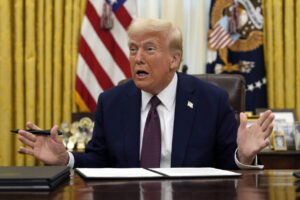Since opening its economy in the late 1970s, China has achieved impressive levels of economic growth. What’s often referred to as its economic “miracle” lifted over 800 million people from poverty and transformed the lower-income nation into an upper-middle-income powerhouse, making up close to one-fifth of the world’s economic output.
So recent warnings of serious economic troubles in China have caught the world’s attention. In the United States, which was already working to “de-risk” its economy from China’s, President Joe Biden called China a “ticking time bomb.”
Despite alarm bells, economists say China is likely not on the verge of collapse, but this could be a turning point.
What’s happening in China’s economy?
While inflation continues to weigh on much of the world, China is facing the opposite problem: deflation. Prices are falling amid an economic slowdown and low consumer spending. The real estate sector is at the center of the slump: property developers are heavily indebted, major firms have defaulted, and dozens more are on the brink. Prices for existing homes have slid 14% in two years.
Business investment is down, and in July, exports experienced their sharpest decline in three years. Meanwhile, local governments are struggling to pay civil servants, and the youth unemployment rate reached 21% before the government stopped publishing the number.
Economists warn of a downward spiral of confidence that could be perilous for the global economy. But not everyone foresees a systemic meltdown.
“There are some real problems in China, but the media observations of what’s been going on are in some ways misplaced,” says Yukon Huang, a senior fellow with Carnegie’s Asia Program. He says the property market is going through a period of adjustment, given that urbanization has nearly peaked and China’s population is no longer growing. Expectations that consumer spending would rebound as it has in the West post-pandemic are unrealistic, he adds, without the same sorts of stimulus packages.
China’s economy is still expected to grow 4.5% this year, nearly twice the projected global rate.
How did we get here?
The underlying problems hampering China’s economy are not new. The first three decades of China’s so-called economic miracle saw a yearly average growth rate of 10%. Productivity soared thanks to a dynamic environment of “bottom-up” decision-making, says Loren Brandt, an economist at the University of Toronto who specializes in China.
That’s changed since the turn of the century, when China began to re-centralize its economy, a process that has intensified under leader Xi Jinping. Productivity has dropped as local economic decisions are made according to national priorities, especially security and self-sufficiency. “They’re often not based on where the capabilities or returns are,” says Dr. Brandt. Confidence in the government’s ability to make the best economic decisions has waned.
In the past, China has responded to economic turmoil by lending more money for infrastructure and real estate, a strategy now made difficult by heavy debt. The government has cut interest rates slightly, eased borrowing restrictions, and lowered the minimum down payment on homes. Many economists say these measures aren’t enough to correct course.
What does this all mean, for China and the rest of the world?
For the world, it means some slowdown in overall growth, amid lower Chinese manufacturing and import activity. Japan saw exports drop in July for the first time in over two years, as purchases of cars and chips by China, its biggest trading partner, fell. More positively, deflation in China may ease inflation globally by pulling down oil prices and the cost of imports from China.
The long-term concern for China is stagnation. While it’s normal for advanced economies to see growth slow over time, China cannot afford a prolonged slowdown with a gross domestic product per capita of $13,700, less than a fifth of that of the U.S.
“A China which grows at 3% is not able to finance its needs,” says Dr. Huang, referring to social spending, research and development, and security interests. “China needs to grow at something closer to 5%.” He sees “huge growth potential” for China if it can address structural issues, such as amending the hukou (household registration) system to allow migrant workers in large cities to buy homes.
Reliable data on China’s economy can be scarce. But over the years, Dr. Brandt has learned to let China surprise him. “We’ve seen this kind of resiliency … this ability to solve these problems and move forward,” he says. “I never want to sell them short.”
Source : The Christian Science Monitor










